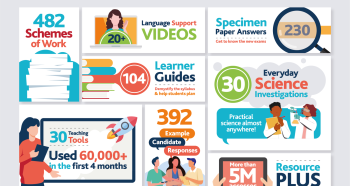Decisions on whether to change a curriculum are never easy. For Cambridge International, it’s about striking a balance between ensuring our learners are receiving the very best international education, while not overwhelming our teaching community with too many changes too often.
When the Cambridge Primary and Lower Secondary curricula were first introduced to the Cambridge Pathway, it felt like the right time to reach out to the growing number of teachers and schools engaged with the programmes to ask them for their views.
If it ain’t broke, don’t fix it!
We carried out extensive consultation on our Primary and Lower Secondary subjects, which came back with a loud and clear message – teachers and schools really liked and valued the curriculum as it was. Of course, they had some suggestions for improvement, but overall there was a high level of satisfaction. The consultation informed us that training, support and assessment were areas where we could make improvements and we embarked on plans to address these. Understanding well the links and dependencies between curriculum, teaching and assessment, we knew that we should also include a review of the curriculum as part of this work.
A change is as good as a rest (or is it?!)
I knew from my own teaching experience that change seemed like a constant feature of my working life; no sooner had I got my head round a specification or a course than it was updated or the school decided to switch to another provider. Precious time and effort spent planning and refining schemes of work, lessons or resources might now be defunct. There was also the uncertainty of teaching something new for the first time – was I confident in all areas covered by the curriculum? Would the learners enjoy the new content as much as the old? We were adamant that we would only make changes to the Primary and Lower Secondary subjects if our review showed we could achieve a better experience for our schools, teachers and learners.
Growing up as a Cambridge Learner – the progression pathway
A key priority for us is that Cambridge Learners moving with us from age 5-18 progress smoothly from one stage of the Cambridge pathway to the next. So when we started looking at the curriculum, progression was a big focus. We started by carrying out progression audits, which showed that the transition points between stages could be smoother. They also highlighted places where curriculum coverage should be more balanced between strands and subject areas. Colleagues and other experts who work closely with our curriculum frameworks then addressed these issues, introducing new learning objectives, removing unnecessary repetition and clarifying wording. Part of the process involves rounds of reviews with many stakeholders involved in refining the final product.
Small changes can make a big difference
The progression audits also allowed us to improve the structure of our curriculum frameworks. In English, for example, there are new Speaking and Listening sub-strands and learning objectives to scaffold the development of spoken language and support reading and writing. For English as a Second Language, we have reduced the overall number of learning objectives, especially in the Use of English strand. We have also moved some learning objectives from one stage to another to ensure better alignment with the Common European Framework of Reference (CEFR). I’m pleased that we have cross-referenced language demands in Science and Mathematics and ensured we are supporting our English as a Second Language learners more effectively through the revised curriculum. Teachers can be confident that the language demands required in Science and Mathematics are supported by the skills that will have been covered in the English as a Second Language curriculum by the same stage.
Science and maths – changes for the better
Teachers will find more substantial changes in our science and mathematics curriculum frameworks. Reviewing these in light of current educational research, (for example, drawing upon the work of Cambridge Mathematics) we realised there were exciting ways we could do more to support learners’ skills development. That’s why we have embedded “Thinking and Working Mathematically” and “Thinking and Working Scientifically” within and across our curriculum strands. We are much more explicit about mental strategies and problem-solving in mathematics and have introduced four pairs of thinking and working characteristics that, together, form a powerful set of skills. In “Thinking and Working Scientifically”, we have broadened the range of scientific skills that learners are expected to develop, including a new focus on developing and understanding scientific models. These, together with other changes in the content, have renewed these programmes – they feel fresh and smart and provide an even better foundation for progression to qualifications in mathematics and the sciences. I think our approach will really help to engage all learners in their foundational learning in these subjects.
Future-proofing our programmes
Four years ago, who could have predicted what would be happening to our world in 2020? We are keen to provide as much support as we can to our teachers and schools and our work on the curriculum forms a key part of that. Equipping learners with knowledge, skills and understanding they can apply to new situations and contexts is one of the best ways we can build their resilience for an uncertain future.
I am really excited about supporting our future scientists, mathematicians, engineers, writers, broadcasters, translators, creative thinkers, problem-solvers, leaders and life-long learners by setting out a great foundation for their learning through the Cambridge Primary and Lower Secondary programmes. I look forward to hearing what our schools, teachers and learners think about the changes we’ve made.





